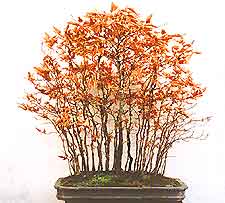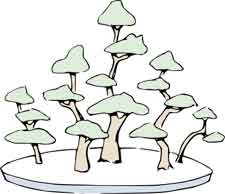Bonsai Trees
Styles: Group Planting - Yose-Ue

Separate trees of one variety are combined to create a natural looking group, such as the one pictured here growing in open countryside. The trees do not need to be individual specimens in their own right. One-sided trees that would not be suitable for other styles can be used and are often desirable, as branches in a group grow out towards the light and not into the centre where light is excluded.
Usually smaller, thinner trees are planted nearer the back and the outside, with larger, heavier trunked trees at the front to create the desired perspective and feeling of distance. Young or old trees can be utilised to create different effects. Small groups should not contain even numbers of trees as the resulting arrangement can look unnatural.
Convincing groups can be created very quickly by selecting suitable trees, such as hedging material, which is often sold bare-rooted in the autumn and is inexpensive. Large, shallow, oval or rectangular pots, slates or stone slabs can be used to good effect, to create a natural landscape.

Formal Upright - Chokkan
Informal Upright - Moyogi
Literati - Bunjingi
Windswept - Fukinagashi
Cascade - Kengai
Twin Trunk - Sokan
Root Over Rock - Sekijoju
Bonsai Root On Rock - Ishitsuki
Bonsai Driftwood - Sharimiki
Bonsai Group Planting - Yose-Ue
Bonsai Broom - Hokidachi
 Separate trees of one variety are combined to create a natural looking group, such as the one pictured here growing in open countryside. The trees do not need to be individual specimens in their own right. One-sided trees that would not be suitable for other styles can be used and are often desirable, as branches in a group grow out towards the light and not into the centre where light is excluded.
Separate trees of one variety are combined to create a natural looking group, such as the one pictured here growing in open countryside. The trees do not need to be individual specimens in their own right. One-sided trees that would not be suitable for other styles can be used and are often desirable, as branches in a group grow out towards the light and not into the centre where light is excluded.